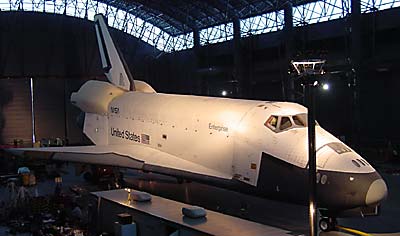A new hangar for the nation’s atticby Jeff Foust
|
| Only about 10 percent of the NASM’s aircraft and spacecraft are on display on the Mall. |
To alleviate this problem, the Smithsonian has tried for years—efforts date back to at least 1980—to build a new, larger museum in the Washington area to house the additional artifacts. In the mid-1990s, Congress authorized the NASM to build a new museum near Dulles Airport, but with a catch: the funding for the project, outside of a token amount for planning, had to come from private sources. Fortunately, the latter half of the 1990s was a fortuitous time for major fundraising efforts, as a strong economy left individuals and businesses flush with cash, and the NASM was able to raise over $300 million. The largest single donation, $65 million, came from Steven F. Udvar-Hazy, president and CEO of International Lease Finance Corporation, a leading commercial aircraft leasing company.
On December 15, after many years of work, the NASM’s Steven F. Udvar-Hazy Center will finally open to the public in a gala celebration. Ten days earlier, the NASM invited members of the media to the new museum for a sneak preview. With nearly all of the museum’s artifacts in place by then—including the space shuttle Enterprise—the preview offered an opportunity to get some background about the museum itself and see what the museum will offer to its first visitors.
The museum at a glance
The first impression that the museum will leave on visitors is its massive scale. The main hangar is 300 meters long, 75 meters wide, and at its peak over 30 meters high. Attached to the side of the main hangar is the James S. McDonnell Space Hangar, home to the Enterprise and (eventually) other space artifacts: it is “merely” 80 meters long, 55 meters wide, and nearly 25 meters tall. Combined, the two hangars have a total area of over 32,000 square meters, most of which is devoted to display space.
Visitors enter the museum through a single main entrance that actually puts them on the second level of the facility. Straight ahead, on the opposite side of the main hangar, is the entrance to the space hangar. This means that Enterprise will be among the first vehicles museum visitors will see when they arrive. The rest of the museum’s vast collection only becomes visible after walking a short distance from the entrance to a viewing point overlooking the floor; from there, stairs lead down to the floor for further exploration. One can, in fact, view the museum quite well without ever setting foot on the museum floor, by using a series of elevated walkways running along both sides of the main hangar. At the very least, they offer a vantage point to plan further exploration on the ground.
| The Enterprise will be among the first vehicles museum visitors will see when they arrive. |
For aviation buffs of any stripe, the new museum will have a lot to offer. Besides the Enterprise, the Udvar-Hazy Center has an Air France Concorde, retired just this summer. Near the Concorde is the Boeing 367-80, or “Dash 80”, the prototype for the Boeing 707 jetliner. In the center of the museum, midway between the entrance and the Enterprise, is the SR-71 Blackbird that set a transcontinental speed record in 1990 when it flew from cost to coast in just over an hour (flying, ironically, to Dulles to be retired and placed in the Smithsonian.) The museum’s most controversial exhibit is the Enola Gay, the B-29 bomber that dropped the atomic bomb on Hiroshima. A few organizations have petitioned the museum to add the number of deaths caused by the bomb to the plane’s description in the museum. The NASM has declined, stating that it does not routinely list casualties caused by other combat aircraft in its collection.
Needless to say, museum officials are very proud of their newest facility. Jack Dailey, NASM director, noted that the museum was finished on schedule and under budget. The Smithsonian had raised $311 million to build the facility, but spent only $290 million on construction. Everything was on track for the December 15 opening (a date selected to commemorate the Wright Brothers centennial, avoiding the actually centennial, December 17, so as not to conflict with events that day at Kitty Hawk) although work was hectic in the weeks leading up to the opening. On the day of the press preview, for example, there was still a lot of superficial cleaning needed in some of the hallways outside the main hangar, and the bathrooms were lacking an essential amenity: toilet paper.
